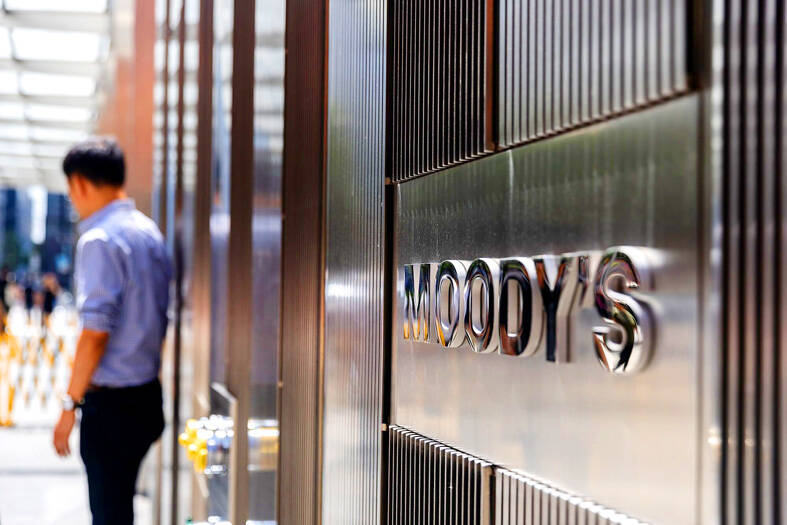Taiwan’s insurance companies are more vulnerable to market volatility triggered by US tariffs due to their smaller capital buffers, while the nation’s banks remain well-capitalized and able to absorb potential economic shocks, two major international ratings agencies said.
Key equity markets across the Asia-Pacific region have fallen by more than 10 percent on average since US President Donald Trump announced sweeping tariff hikes on April 2, Moody’s Ratings said.
The sweeping import tariff regime is credit negative for regional insurers, it said, citing the immediate impact of heightened capital market volatility, as well as medium-term risks such as weaker insurance demand and higher claims costs resulting from slower economic growth and inflationary pressures.

Photo: AFP
Among the markets, insurers in Taiwan are the most exposed to market volatility, while Chinese insurers could face heightened negative spread risks, as Beijing’s central bank responds with easing policies, Moody’s Ratings said.
Taiwanese insurers are particularly vulnerable to falling equity prices due to their relatively lower capital buffers, the agency said.
Several major life insurers have already reported a 15 percent decline in unrealized capital gains during the first quarter — a figure that could worsen this month amid continued global stock market turbulence.
In China, regulators have encouraged life insurers to boost their equity holdings to help stabilize the market.
However, Moody’s cautioned that this approach could increase insurers’ overall equity exposure, making their capital positions and earnings more sensitive to market volatility.
In response to the volatility, the Financial Supervisory Commission has asked domestic life insurers to assess their cash and debt positions, and ensure adequate liquidity to protect the interests of policyholders and avoid a potential liquidity trap.
The commission is especially monitoring whether a wave of policy cancelations or terminations follows the stock market slump.
So far, it has not observed any significant or abnormal spike in cancellations, but said it would continue to monitor the situation as uncertainty lingers.
In contrast, the nation’s banks remain sufficiently capitalized and are in a strong position to absorb potential economic shocks over the next 12 months, which carries great importance this year, Taiwan Ratings Corp (中華信評) said.
“Banks could increasingly need this buffer this year because strong ties between Taiwan’s economic performance and US economic policies could weigh on the sector’s performance,” the local arm of S&P Global Ratings said.
Taiwan’s growing reliance on the US economy exposes the domestic economy to higher risk of US policy changes, it said.
The US is Taiwan’s second-largest trade partner, accounting for the bulk of shipments of electronics used in smartphones and artificial intelligence applications.
This dependence could impact Taiwanese households and businesses — and potentially its banking sector — if the US steeply raises trade barriers, Taiwan Ratings said.
Credit losses could increase in weaker sectors of the economy amid rising economic uncertainties, it said.

SELL-OFF: Investors expect tariff-driven volatility as the local boarse reopens today, while analysts say government support and solid fundamentals would steady sentiment Local investors are bracing for a sharp market downturn today as the nation’s financial markets resume trading following a two-day closure for national holidays before the weekend, with sentiment rattled by US President Donald Trump’s sweeping tariff announcement. Trump’s unveiling of new “reciprocal tariffs” on Wednesday triggered a sell-off in global markets, with the FTSE Taiwan Index Futures — a benchmark for Taiwanese equities traded in Singapore — tumbling 9.2 percent over the past two sessions. Meanwhile, the American depositary receipts (ADRs) of Taiwan Semiconductor Manufacturing Co (TSMC, 台積電), the most heavily weighted stock on the TAIEX, plunged 13.8 percent in

A wave of stop-loss selling and panic selling hit Taiwan's stock market at its opening today, with the weighted index plunging 2,086 points — a drop of more than 9.7 percent — marking the largest intraday point and percentage loss on record. The index bottomed out at 19,212.02, while futures were locked limit-down, with more than 1,000 stocks hitting their daily drop limit. Three heavyweight stocks — Taiwan Semiconductor Manufacturing Co (TSMC, 台積電), Hon Hai Precision Industry Co (Foxconn, 鴻海精密) and MediaTek (聯發科) — hit their limit-down prices as soon as the market opened, falling to NT$848 (US$25.54), NT$138.5 and NT$1,295 respectively. TSMC's

TARIFFS: The global ‘panic atmosphere remains strong,’ and foreign investors have continued to sell their holdings since the start of the year, the Ministry of Finance said The government yesterday authorized the activation of its NT$500 billion (US$15.15 billion) National Stabilization Fund (NSF) to prop up the local stock market after two days of sharp falls in reaction to US President Donald Trump’s new import tariffs. The Ministry of Finance said in a statement after the market close that the steering committee of the fund had been given the go-ahead to intervene in the market to bolster Taiwanese shares in a time of crisis. The fund has been authorized to use its assets “to carry out market stabilization tasks as appropriate to maintain the stability of Taiwan’s

STEEP DECLINE: Yesterday’s drop was the third-steepest in its history, the steepest being Monday’s drop in the wake of the tariff announcement on Wednesday last week Taiwanese stocks continued their heavy sell-off yesterday, as concerns over US tariffs and unwinding of leveraged bets weighed on the market. The benchmark TAIEX plunged 1,068.19 points, or 5.79 percent, to 17,391.76, notching the biggest drop among Asian peers as it hit a 15-month low. The decline came even after the government on late Tuesday authorized the NT$500 billion (US$15.2 billion) National Stabilization Fund (國安基金) to step in to buoy the market amid investors’ worries over tariffs imposed by US President Donald Trump. Yesterday’s decline was the third-steepest in its history, trailing only the declines of 2,065.87 points on Monday and